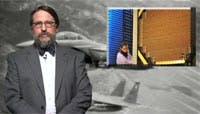THE MIL & AERO VIDEO BLOG. I'm noticing some very interesting defense work on fundamental improvements to phased array radar that has the potential for big payoffs in the size, range, and sensitivity of future radar systems, and even may lead to covert RF sensors that previously were limited only to the electro-optical domain.
Earlier this month the Defense Advanced Research Projects Agency, or DARPA, gave the go-head to Teledyne Scientific and Imaging in Thousand Oaks, California, to move into the advanced stages of a microelectronics program that ultimately may create the ability to fabricate phased-array radar transmit-and-receive modules on a wafer -- much the same way that companies have been fabricating integrated circuits on wafers for many years.
This program is called Scalable Millimeter-wave Architectures for Reconfigurable Transceivers -- SMART, for short -- which Teledyne has been working on for several years. Now, in the Phase IIIB part of the program, Teledyne scientists are attempting to create deployable SMART technologies, possibly for future military radar and communications systems.
Teledyne now is trying to create high-yield SMART components at advanced technology readiness levels, and move SMART technology to batch fabrication for a yet-unnamed military application that requires millimeter-wave capability.
The SMART program essentially seeks to develop wafer-scale integration for RF and microwave transmit-and-receive modules, and is trying to develop 3-dimensional MMIC chips that can fit small power amplifiers between transmit-receive nodes in a phased array antenna. This cold enhance the efficiency and sensitivity of radar and communications systems.
So far Teledyne engineers have developed 44-GHz transmit sub-arrays, and demonstrated a millimeter wave tiled array by inventing a way to integrate silicon digital beam-forming with compound indium phosphide power amplifier MMICs.
If that weren't enough, there's more radar technology in the news.
The Air Force this month revealed a program called Phased Array Antenna for Passive RF Sensing, which might lead to covert passive radar surveillance capability for ground sites and aircraft.
Covert radar surveillance is a bigger deal than it might sound. Radar, by its nature, transmits radio waves, which alerts anyone nearby to its presence. Turning on a radar is kind of like sweeping a flashlight around a darkened room. You might find what you're looking for, but everyone knows you're there.
The Air Force Research Lab at Wright-Patterson Air Force Base in Ohio is asking industry to develop revolutionary new wideband dual polarized phased array radar antenna technologies for this program, which seeks to develop analog and digital beam forming techniques that could provide as many as 64 independent beams simultaneously.
That means the kind of radar technology the Air Force envisions might, at worst, prevent an adversary from pinpointing the radar's transmitter. At best, it might develop a radar with a signal that essentially hides in the RF noise without tipping off an adversary that he's being watched.
So next time you think of radar old, mundane technology, think again. Today's research is liable to take radar a lot further forward.

